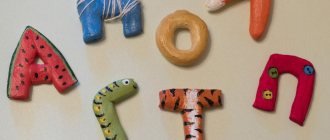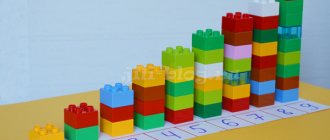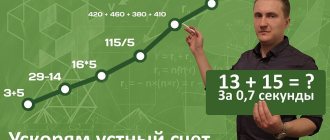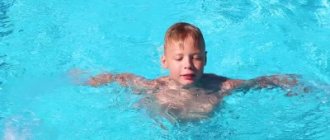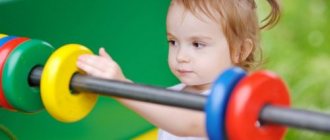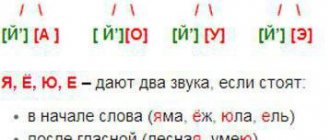What to do if your child cannot remember numbers? How to help?
Our Masha is smart. Very smart and talented and... Well, you get the idea.
But I couldn’t remember the numbers! No matter how much they repeated it, or counted it, they stuck the stickers on - no use.
All the numbers for Masha were the same.
Stop!
"On one face"
Here it is! This turned out to be the main secret of Masha and many other children.
It's all about perception! It varies from person to person. Not only for children, by the way.
There are children for whom a one is a one, and a two is a two. Well, you know, like a donkey is a donkey, and a lamb is a lamb. You'd probably be surprised if your child couldn't tell the difference between a donkey and a ram, right?
And there are children for whom one, two, three and everything, everything, everything (as well as letters!) -
JUST FOR - KO - RYU - CHKI!
And now imagine. They give you a sheet of squiggles and say:
- This squiggle is called “one”, this one is “two”, and this one is actually the letter “a”! Do you remember everything? Repeat!
Introduced? Scary? That’s how it is for children who can’t remember numbers and letters.
Well, okay, there’s nothing scary about it now, because we’ve already come up with a solution that helped us learn first the letters and then the numbers.
Our “ABC of Little Poets” will help you learn the letters, and today we will tell you about
Development in everyday life: how easy it is to learn numbers with a child?
Illustrative photo: Pexels.com Hardly any adult is able to recall the first time he learned to recognize numbers. However, this does not at all detract from the significance of this process. Teaching numbers is a “core program” for children that must be mastered. If it is desirable to know letters before school, then numbers are a must, and the task of teaching the child this lies with the parents.
Why is it difficult to remember numbers?
Most often, the child thinks that they are similar: 3 and 2, 1 and 7, 9 and 6 - you must agree, there is something in common in the spelling of their elements.
Another reason is that the preschooler does not understand the meaning of the material being studied: what are the numbers for? What do they mean? Why should he teach them?
How to learn numbers with your child in this case? Pediatric neuropsychologist Leysan Usacheva talks about this on her Instagram blog.
“If it is difficult to explain to a small child why it is necessary to learn so many letters, then there is a strong argument in favor of numbers: in order to be able to buy ice cream in the store themselves.
And then the baby, after thinking a little, begins to understand that this will definitely be useful to him,” writes Leysan Usacheva (hereinafter, the author’s spelling and punctuation are preserved - editor’s note)
According to the expert, some of the tasks may be similar to those used in the process of teaching letters. Read about how to quickly and easily learn the alphabet with your child in a previously published article on NUR.KZ.
You can add the use of household items such as:
- Remote control - switch to channel 5.
- Scales - what number do they show?
- Clock - what number is the hand near?
- Calendar - place as many candies on the table as are written on the calendar.
- Telephone - dial a number from dictation.
However, it is not enough to know the numbers; you also need to learn to count. And for this, catch the following ideas from Leysan Usacheva.
“Count together everything in front of you. Let's say the child has already counted everything. Now some amount has been eaten, lost, put in a bag, thrown in the trash. How much is left?
Next, taking into account the fact that your child already knows by heart the number of people in the family, play games outside the home,” the psychologist suggests.
Games in the store:
- Get everyone an orange.
- Take yoghurt for everyone except dad (he doesn’t like it);
- Get everyone a chocolate bar, except for mom (she’s on a diet) and little sister (she doesn’t have teeth yet).
- Take two apples for everyone.
- Divide equally among everyone.
- Look how much there is and tell me if there is enough for everyone.
“If your child doesn’t know how to multiply, he can put apples in a bag twice the number of people in the family.
Of course, first you will solve these problems together. And then send the child on an independent “counting” journey. Sit back and watch as your baby stands and fiddles with his fingers, trying to get everything right.
In addition to learning to count, these tasks form correct abstract thinking (based on visual and tactile perception),” summed up Leysan Usacheva.
Original article: https://www.nur.kz/family/children/1921237-razvitie-v-bytu-kak-vyuchit-tsifry-s-rebenkom/
the essence of the technique
How to help? Very simple! Let’s return to the essence of, let’s say, “trouble” (it’s terrible how I don’t like the word “problem”).
All the numbers look the same! This means we need to “come up with a face” for each number!
That is, the shape of each number should stop becoming a squiggle for the child, but should become special, memorable.
And, of course, it should be remembered not just like that, but along with the name.
We took all these conditions into account and came up with association poems. But the associations are not just with the number (you will find many of these), but also with the shape of the number. The name of the number is intentionally rhyming. Now one number cannot be confused with another.
Yes! In each picture, be sure to look with your child for exactly as much of something as the number indicates.
Important addition to the article dated April 16, 2019! Our final and complete version of the Verse Account is ready! Click here to go to the revised collection of Poems with coloring pages and copybooks
✕
How to teach your child numbers: games and exercises
First steps
First, show your child what a number looks like, explaining that this symbol stands for, for example, one. Then move on to entertainment: paint a number with your child, cut it out of paper, sculpt it from plasticine.
Next is training and testing. Has the child learned to distinguish a number from others? In order to find out this, there are corresponding exercises. For example, make cards of different shapes and colors, each with a number on it. Then ask the child, selecting cards one at a time, to put aside those on which the desired one is drawn. You can do the same with cubes or chips.
Magic “Poem Counting” technique
0 - zero
There is not a single steering wheel!
So this is the number ZERO!
1 - one
Thin nosed gentleman
There is always ONE standing like a pillar!
2 - two
The swan barely swam to us,
Turned into number two!
3 - three
Rub two rings
And you get the number three!
4 - four
This is a hanger in the apartment!
And also the number four!
5 - five
If the tail is rounded,
You will immediately become number five!
6 - six
Is there a tail on top of the circle?!
So this is number six!
7 - seven
The pole is completely askew!
The result is number seven!
8 - eight
We'll ask for a tumbler
Become number eight today!
Preparing for teaching children under 3 years old
A preschooler aged 2 to 3 years is a “want” child. It is difficult to captivate him with something for a long time, and even more so with such a complex task as learning numbers up to 10. But nothing is impossible for loving parents. It’s worth building learning in a playful way! You need to memorize them by ear and pay attention to them everywhere!
In this case, parents need:
- tune in to the baby’s “wave”. If at a certain moment he doesn’t want to play even with you, you shouldn’t force him. This will only lead to complete protest. It’s worth waiting until the baby is in the mood or, for example... come to an agreement. The baby pays attention to numbers every day for 5 (10-15-20) minutes, and you allow him... to play with the tablet for the same number of minutes;
- Don't turn teaching 1 to 10 into an academic lesson. A child aged 3 years old will not like learning at a desk, but learning in dynamics will attract him. You can conduct lessons “like in school” (only of a much shorter duration) with a child aged 4 years and older;
- Be sure to check your knowledge. Arrange an interesting exam in which not only the child’s memory will be involved, but also logic, attention, and imagination.
We study the concept of “The same amount”
Here are a few examples of our very first games with quantities (we played them at the age of about 2 years):
- We place 2-3 toys at the table, inform the child that today is one of them’s birthday, so all the guests need to be fed. To begin with, we count together how many guests there are and with the words “So, there are only 3 guests, which means we will need 3 plates too,” we count out three plates with the baby. We arrange them for the guests, check that there is enough for everyone, which means that there are as many as there are toys. Similarly, you can give tasks for distributing spoons or chairs for toys.
- Then, in the voice of the doll Masha, we say, “Can I please have 3 mushrooms?” We count out 3 mushrooms for Masha. Then we reason that the frog should be given the same amount so as not to offend him. We count out 3 mushrooms for him too. The concept of “ the same amount ” was re-established.
In the game, you can use any available counting material (cones, buttons, counting sticks) or purchased ones (mushrooms, carrots, tomatoes).
- You don’t have to limit yourself to just the theme of tea drinking; mathematics can be added to any role-playing games. For example, put the same number of houses as there are animals, draw the same number of berries as there are hedgehogs in the picture, etc. The main thing is to harmoniously weave the task into the plot of the game, telling the story that the animals were left without housing, etc.
Mathematics for kids. Basic principles
The math games that I want to talk about in this article are best suited for children 2-4 years old (and some even earlier). The main goal of these games is to teach the child to visually recognize a number, to understand which is larger, which is smaller, which are the same, which quantity corresponds to each number, and what will happen if you add one more to three apples. I would like to note that these are games, not lessons. Children at this age will not like it too much if you constantly torture them with questions like “Show me the number 3” “Tell me how many sticks are there?” They need to be interested by unobtrusively adding math problems to everyday story games. I notice the highest interest in my daughter when her favorite toy personally tells her about her problem and asks her for help (I’m talking about the toy, of course).
Don't try to play with big numbers right away! It is enough to limit yourself to 4-5 games. Agree, it is much more attractive to help a child master various operations with numbers not exceeding the number 4 and develop mathematical thinking than to simply learn to count to ten without knowing how to operate with each of these numbers. A child who has mastered operations with small numbers will then easily transfer his skills to large numbers.
So, math games for kids:
Getting acquainted with numbers, establishing the relationship between numbers and quantities
Once your child has some idea of quantities, you can start introducing numbers. Now, having calculated something, you not only name the number, but also show the corresponding figure. Here are some more options for math games:
- We build towers from construction sets or cubes of the appropriate size;
- We attach a suitable number of clothespins-hair (HERE YOU CAN DOWNLOAD our head templates);
- We select dominoes with the required number of dots (to diversify the game, you can invite your child to transport dominoes to numbered houses on a typewriter);
- We lay out tracks from counting sticks and select the appropriate numbers - the length of the resulting tracks will help the child understand which number is larger;
- We put the required number of matches into the numbered boxes;
- We put the required number of cubes into the cars with numbers (the cars can be drawn on paper);
- You can also use ready-made solutions, like this game “Numbers” (Ozon, Labyrinth, My-shop)
or insert frame (Ozon, My-shop, Read)
